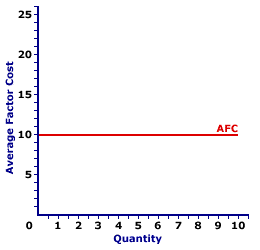
|
|
PHENOMENON: An event or action that is subject to investigation using the scientific method. Phenomena are the sorts of things that science seeks to explain. While the term phenomenon might entice thoughts of UFOs, ghosts, and three-headed turtles, it really just means things that happen, both usual and unusual. The reason for explaining the unusual AND the commonplace is that the scientific method seeks to develop universal theories, with laws and principles that explain all events, not just unexpected ones.
Visit the GLOSS*arama
|
|


|

|
                           AVERAGE FACTOR COST CURVE, PERFECT COMPETITION: A curve that graphically represents the relation between average factor cost incurred by a perfectly competitive firm for employing an input and the quantity of input used. Because average factor cost is essentially the price of the input, the average factor cost curve is also the supply curve for the input. The average factor cost curve for a perfectly competitive firm with no market control is horizontal. The average revenue curve for a firm with market control is positively sloped. Perfect competition is a market structure with a large number of small participants (buyers and sellers). The good exchanged in the market is identical, regardless of who sells or who buys. Participants have perfect knowledge and perfect mobility into and out of the market. These conditions mean perfectly competitive buyers are price takers, they have no market control and must pay the going market price for all inputs bought.The average factor cost curve reflects the degree of market control held by a firm. For a perfectly competitive firm with no market control, the average factor cost curve is a horizontal line. For firms with market control, especially monopsony, the average factor cost curve is positively sloped. Average Factor Cost Curve,
Perfect Competition |  |
A typical average factor cost for perfect competition is displayed in the exhibit to the right. This particular average factor cost curve is that for labor hired by Maggie's Macrame Shoppe. Maggie's Macrame Shoppe is one of thousands of small retail stores in the greater Shady Valley metropolitan area that hires labor with identical skills. As such, Maggie pays the going wage for labor.The vertical axis measures average factor cost and the horizontal axis measures the quantity of input (workers). Although quantity on this particular graph stops at 10 workers, the nature of perfect competition indicates it could easily go higher. First and foremost, the average factor cost curve is horizontal at the going factor price of $10. This indicates that if Maggie hires 1 worker, then she pays an average factor cost of $10. Alternatively, if she hires 10 workers, then she pays an average factor cost of $10. Should she hire 100 workers, then she might move well beyond the graph, but she pays an average factor cost of $10. The "curve" is actually a "straight line" because Maggie is a price taker in the labor market. She pays $10 for each worker whether she hires 1 worker or 10 workers or 100 workers. The constant price is what makes Maggie's average factor cost curve a straight line, and which indicates that Maggie has no market control.

Recommended Citation:AVERAGE FACTOR COST CURVE, PERFECT COMPETITION, AmosWEB Encyclonomic WEB*pedia, http://www.AmosWEB.com, AmosWEB LLC, 2000-2025. [Accessed: June 30, 2025].
Check Out These Related Terms... | | | | | | | | | | |
Or For A Little Background... | | | | | | | | | | | |
And For Further Study... | | | | | | | | |
Search Again?
Back to the WEB*pedia
|



|

|
GRAY SKITTERY
[What's This?]
Today, you are likely to spend a great deal of time strolling around a discount warehouse buying club seeking to buy either a flower arrangement with a lot of roses for your grandmother or a wall poster commemorating the first day of winter. Be on the lookout for cardboard boxes.
Your Complete Scope
This isn't me! What am I?
|

|
|
Junk bonds are so called because they have a better than 50% chance of default, carrying a Standard & Poor's rating of CC or lower.
|

|
|
"I learned about the strength you can get from a close family life. I learned to keep going, even in bad times. I learned not to despair, even when my world was falling apart. I learned that there are no free lunches. And I learned the value of hard work. " -- Lee Iacocca
|

|
AACCLA
Association of American Chambers of Commerce in Latin America
|

|
|
Tell us what you think about AmosWEB. Like what you see? Have suggestions for improvements? Let us know. Click the User Feedback link.
User Feedback
|


|


